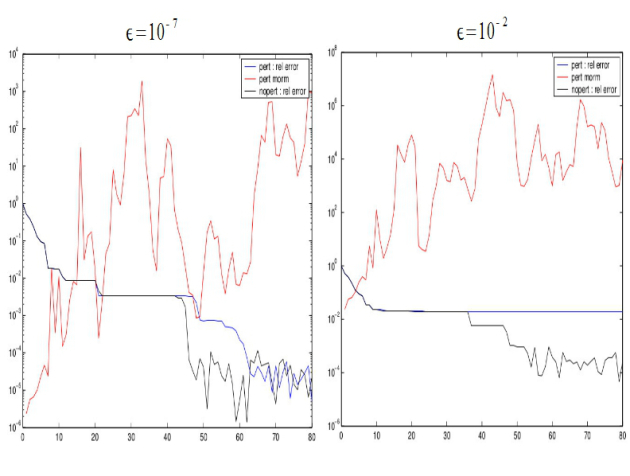The inexact CG for solving Ax = b
Inexact CG method
Take the basic CG method,
And perturb the matrix-vector products

Easy way to control the inner {\em accuracy}.
Why ?
The matrix is not known with full accuracy (Parameter estimation, Schur complement,...)
Computing
 with a poor accuracy is cheap (FMM)
with a poor accuracy is cheap (FMM)
The inexact CG Algorithm
|
Idea
Assume that
 goes to
goes to

Control the residual gap
 by using
by using

Note that for the exact algorithm,
 is nonincreasing.
is nonincreasing.Therefore, the norm chosen for the analysis is
 for residual space, and the adjoint norm
for residual space, and the adjoint norm
 for the solution space.
for the solution space. To make this norm relative, we introduce the backward error

where
 .
.It is possible to show that
 .
.
The residual gap
Fundamental : Proposition 7
The residual gap in the inexact CG satisfies

Proof
By an inductive argument. We have
 0 and
0 and
 .
.
Suppose the result true until step
 . We have
. We have
 .
.
Control of the residual gap(I)
Fundamental : Proposition 8
We consider the matrix norm
 .
.
Assume that
 ,
,
The residual gap in the inexact CG satisfies

Proof
We have
 , and
, and
 concludes the proof.
concludes the proof.
Fundamental : A useful Lemma
Lemma 30
Let
 be a symmetric and positive definite matrix. We consider the matrix norm
be a symmetric and positive definite matrix. We consider the matrix norm
 .
.
For any symmetric matrix
 , if
, if
 holds, the matrix
holds, the matrix
 is symmetric positive definite.
is symmetric positive definite.
Proof
Assume that
 . From the definition of the norm
. From the definition of the norm
 we get
we get
 ,
,
which shows that
 , where
, where
 denotes the spectral norm.
denotes the spectral norm.
Using
 ,
,
we get that
 is symmetric and positive definite.
is symmetric and positive definite.
Using the Theorem of inertia of Sylvester yields that
 is symmetric and positive definite, which is the desired result.
is symmetric and positive definite, which is the desired result.
Control of the residual gap (II)
Fundamental : Proposition 9
Let
 and let
and let
 be a positive vector such that
be a positive vector such that
 .
.
If
 ,
,
we have that, for


Proof
If
 ,
,
we have that
 ,
,
which yields
 .
.
Using
 , we get that
, we get that
 .
.
Lemma (
 )shows that
)shows that
 is symmetric positive definite,
is symmetric positive definite,
which implies that
 .
.
In addition, we have
 , which yields
, which yields

Taking into account that by definition we have that
 , we obtain that
, we obtain that
 . Using Proposition (
. Using Proposition (
 )gives
)gives
















